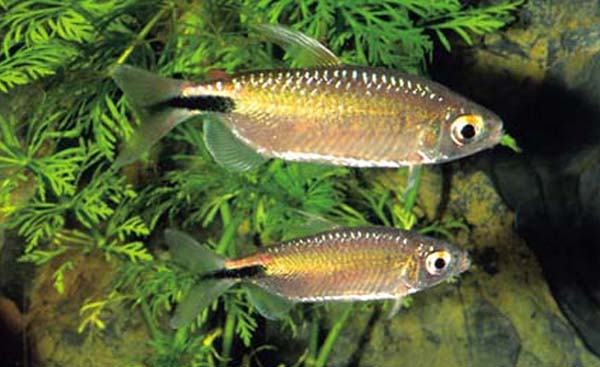| Alestidae (African tetras) |
| 16.4 cm TL (male/unsexed) |
|
pelagic; freshwater; brackish; pH range: 6 - 8; dH range: 5 - 19, potamodromous |
| Africa: present along the Atlantic border of the African continent from Gambia to the Democratic Republic of the Congo (Ref. 2880, 5331, 80290, 81279). Generally found in upper as well as lower river courses and may even occur in brackish waters of estuarine areas (Ref. 2880, 81279). Only Brycinus species that inhabits smaller water courses (Ref. 80290). |
|
Anal spines: 0-0; Anal soft rays: 18-26. Diagnosis: fronto-parietal fontanel narrow, but always present; 25-34 lateral line scales; 5.5 scales between lateral line and dorsal fin; 15-23 anal fin branched rays; 13-15 gill rakers on lower limb of first gill arch; 6 teeth in outer premaxillary row (Ref. 2880, 80290, 81279). Head length/snout length 3.3-4.4; 8.5-11.5 predorsal scales (Ref. 80290). Precaudal spot elongate, extending to end of caudal fin (Ref. 81279).
Description: dorsal-fin origin at about same level as pelvic-fin insertions; anal fin with 3 branched and 15-23 unbranched rays; jaws equal, six outer premaxillary teeth aligned in one row; sexual dimorphism affecting anal-fin shape in adult males which have first rays of dorsal and pelvic fins rays prolonged, the dorsal filament extending beyond the adipose fin, and pelvic filament reaching to anal fin, when pressed to body; in sexually mature males body depth increases with growth at faster rate than females (Ref. 2880, 80290, 81279).
Coloration: humeral spot; broad precaudal band extending over entire length of caudal peduncle and continuing backwards on median caudal-fin rays to hind margin of caudal fork; body color silvery, back greenish and belly white; adult males with unpaired fins and sometimes also terminal filaments of pelvic fins red-violet, bright red spot above eye; females with pale orange fins, yellow blotch on each caudal-fin lobe, orange spot above eye (Ref. 2880, 80290, 81279). |
| Generally found in the upper and lower reaches of big rivers and also in estuarine zones of mixohaline waters (Ref. 2880). The only Brycinus species to penetrate small rivers and streams (Ref. 2880), but such specimens are always smaller than those in large rivers (Ref. 80290). Aquarium keeping: in groups of 5 or more individuals; minimum aquarium size 100 cm (Ref. 51150). |
|
Least Concern (LC); Date assessed: 15 April 2019 Ref. (130435)
|
| harmless |
Source and more info: www.fishbase.org. For personal, classroom, and other internal use only. Not for publication.

